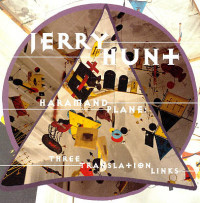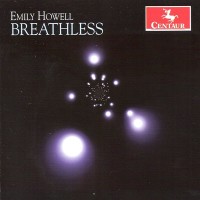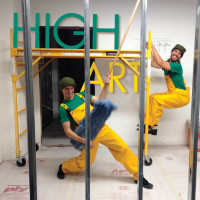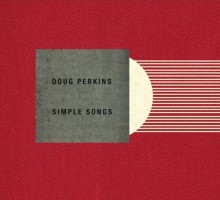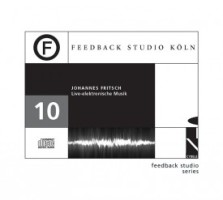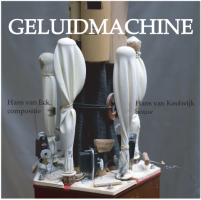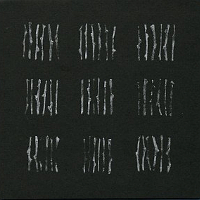EA Bucket 20.
|
Grant Chu Covell [June 2014.]
“Haramand Plane: Three Translation Links.” Jerry HUNT: Chimanzzi: Link (1) (1993); Chimanzzi: Link (2) (1993); Chimanzzi: Drape: Link [Derivative Extraction: (Birome: Zone): Plane: (Fixture)] (1993). Pogus P201069-2 (1 CD) (http://www.pogus.com/). Pogus has reissued content from ¿What Next? Recordings (WN0015) which had been released earlier as OO Discs 38. While I won’t claim to understand what these dense works are about, I do find them absorbing. Hunt’s real-time performances, involving self-made electronics, followed obscure paths. The results convince even though we may never know Hunt’s intentions and actions. Consider the jargon-riddled notes: “Strings of interaction strategies are embedded throughout the time lists for these three complex composite sample-fields works.” Perhaps Hunt really was a technology-adept medium reinterpreting mystical pronouncements by John Dee and Edward Kelley. Or maybe the convoluted proclamations are mere sleight-of-hand. The latter part of Chimanzzi: Link (2) displays an unexpected sweeping grandeur following the quivering, fidgety restlessness of its surroundings. There’s not much of Hunt’s work out there and we should be giddy to have this.
“Emily Howell: Breathless.” David COPE: Silver Blood (2009-12); SpaceTime (2010); Breathless (2012); From the Willows Keep (2010); Coming Home (2009); Prescience (2012). Centaur CRC 3255 (1 CD) (http://www.centaurrecords.com/). Emily Howell is the name which David Cope has bestowed upon a computer program that creates music modeled upon the results of another computer program, Emmy (a.k.a. EMI or Experiments in Musical Intelligence). An astute reader noticing “using Emily Howell” in the technical notes may otherwise wonder what Ms. Howell’s role might actually have been. Cope has spent much of his career developing and tweaking such programs and processes. The results aren’t as preposterous as the titles or any thumbnail description might suggest. Fast and slow moving events are layered, but not quite as melody and accompaniment. In some pieces specific instruments are suggested with a synthesized orchestra, others employ neutral electronic noises. I have heard vastly less interesting ea written by humans. There’s enough to sustain interest, even if we didn’t suspect that latent semantic analysis lurks beneath the knobs and tubes. Presumably, Cope makes the final decisions. These results stand up much better than his efforts to recreate Bach, Mozart, Rachmaninoff, et al.
“The Living Earth Show: High Art.” Samuel Carl ADAMS: Tension Studies (2011). Timo ANDRES: You broke it, you bought it (2011). Adrian KNIGHT: Family Man (2012). Jon RUSSELL: Repetitive Stress (2012). Travis Andrews (guit), Andy Meyerson (perc). Innova 863 (1 CD) (http://www.innova.mu/). A versatile guitarist and percussionist offer duos which break the guitar-plus-percussion stereotype. The cover may mislead: This is not an industrial-workout soundtrack. Adams’ two Tension Studies include electroacoustic underlays. The tension is actually subjective as these long works proceed as unencumbered explorations of color set in motion with compact gestures. Andres’ short work derives from a bit of the Mozart “Coronation” Concerto he completed. I wasn’t able to tell, but no matter. Slowly unfolding Family Man is the longest essay, and suggests a forgotten America when TV was in black and white. Electroacoustic intertitles feature a slide projector’s nostalgic clicks. Russell’s Repetitive Stress provides the expected high-voltage amped guitar and drum set. Very cleanly recorded and articulated, exposing a range of details not usually associated with this combo.
“Simple Songs.” Nathan DAVIS: Simple Songs of Birth and Return (2007). Tristan PERICH: Momentary Expanse (2008). Beau SIEVERS: Spatial Network for Percussion (2009). David LANG: Unchained Melody (2004). Michael GORDON: XY (1998). Doug Perkins (perc). New Focus Recordings FCR126 (1 CD) (http://www.newfocusrecordings.com/). Perkins demonstrates that the percussionist’s solo repertoire extends to electronics. Davis’ Songs pits mbira against electronics processing. For A Tale Begun, the African thumb piano stays afloat, whereas for Two Shadows, it eventually drowns under controlled feedback. Perich’s Momentary Expanse balances reverberant vibraphone with similar pure (also called one-bit) simple waves. Sievers’ Spatial Network also adds electronics, but the form of the piece can change per performance. Each pitch in Lang’s Unchained Melody is actually associated with a non-pitched sound. The effect is something like a duet or prepared piano. XY perpetuates the percussionist’s need to hit things. The subtlety here is that the hands must operate at different rates and dynamics. Instead of notes we get an amusing 12-page comic book by Matthew Guerrieri.
“Feedback Studio 10.” Johannes FRITSCH: Duett (1961)1; Madrigal triste (1963)2; Concerto da Camera (1964)3; Partita (1965-66)4; Ode (1980)5. Johannes Fritsch1,4 (vla), Lother Faber2 (ob), Patricio Cádiz3 (vln), Rheinisches Kammerorchester3, Thomas Baldner3 (cond.), Rolf Gehlhaar4, Alfred Alings4, Karlheinz Stockhausen4 (microphones, filters, mixers), Dieter Wernecke5 (speaker), Michael Ranta5 (perc), Volker Müller5 (sound). Cybele Records CD 960.310 (1 CD) (http://www.cybele.de/). Quite understandably, works created at the dawn of the live-electronics era show signs of wear today. Certainly Madrigal triste sounds exactly as you would expect a piece from 1963 for oboe and tape (predominantly pre-recorded oboe) to sound. A student of B.A. Zimmermann and Stockhausen, Fritsch was in the right place at the right time and skillfully blended polystylism and electronics. It’s possible not to notice the pervasive Mahler quotes near Partita’s start or the standard violin repertoire excerpts in Concerto, yet there is more going on here than just historical rummaging and dial twisting. Fritsch plays against himself in the somewhat conventional Duett, and later Stockhausen’s crew enacts serious manipulations in Partita, which occasionally sounds as if the solo viola is being dragged across the floor. Ode is a slow monolith intoning Confucius in German over percussion and bells. There is a larger structure detailed in the notes translated by our own Dan Albertson.
“Geluidmachine.” Hans van ECK: Passages (2009-10). (1 CD) (http://www.free-scores.nl/bestel2n.html). Five bamboo flutes integrated into Hans van Koolwijk’s sculptural machine wheeze and flutter. Van Eck designed the program that controls the flutes and their harmonics, producing sounds that glide and phase. This release offers 55 minutes of a basic composition that may stretch to 24 hours. Everything is housed in a large egg-shaped space, with the device’s basics recorded up close. Fourteen named tracks flow effortlessly, one into the other, a bit like Ligeti’s metronome symphony. One imagines toy trains or animated tea kettles. The “Sound Machine” is described here, in Dutch.
“Still and Moving Lines.” Alvin LUCIER: Ever Present (2002); Carbon Copies (1989); Hands (1994); Shelter (1967). Decibel: Cat Hope (fl, a-fl, org), Lindsay Vickery (sax, org), Stuart James (pno, org), Malcolm Riddoch (electronics, org). Pogus 21072-2 (1 CD) (http://www.pogus.com/). While Lucier’s music remains difficult to describe, this Pogus release featuring Decibel, a new music ensemble out of Perth, Australia, does a fantastic job. Lucier incorporated electronics early on, most specifically the gritty sweep of a sine wave or oscillator. In Lucier’s work, we’re always aware of progress within a cycle or larger pattern. Ever Present, a trio for flute, sax and piano, drops pitches across a web created by two slowly rolling waves, as if tossing darts at a swaying clothesline. Carbon Copies offers four versions of the same event: an environmental recording, players (sax, flute and piano) accompanying the recording attempting to imitate it. The trio tries again. This time only they can hear the original recording, and finally the threesome is completely alone. Even though the musicians have specified tasks and are aware of the repetitions, the listener has difficulty identifying the cycles. In Hands, a team of four manipulates organ stops to change a chord’s harmonics and color. Shelter uses contact microphones to capture the sounds that reverberate in a concert space, amplified, filtered and replayed in the same space. We are hearing what the building heard when there was little to hear. This release is in Pogus’ new space-saving packaging: An 11×17 sheet folded in sixths creates a nearly square booklet. The CD comes along in a sleeve.
Andres, Cope, D Lang, Fritsch, Gordon, Hunt, Knight, Lucier, N Davis, Perich, Russell, SC Adams, Sievers, van Eck
[More EA Bucket, Grant Chu Covell]
[More
Andres, Cope, D Lang, Fritsch, Gordon, Hunt, Knight, Lucier, N Davis, Perich, Russell, SC Adams, Sievers, van Eck]
[Previous Article:
Used Bin Troll Tweets H.]
[Next Article:
Maestro di Suoni e Silenzi: Necessary Nono 4.]
|
